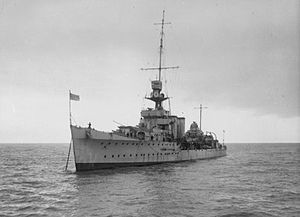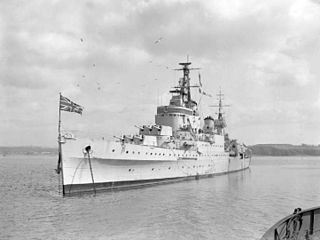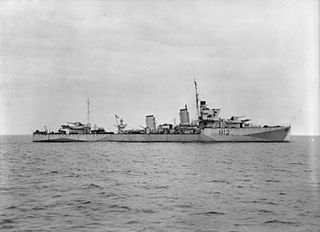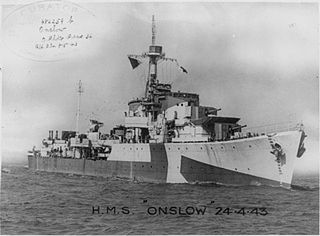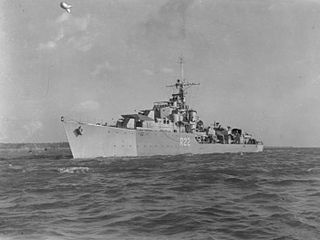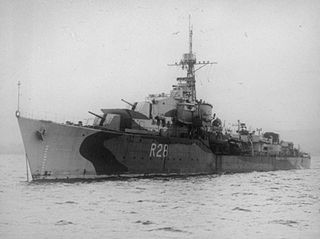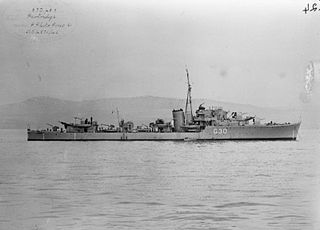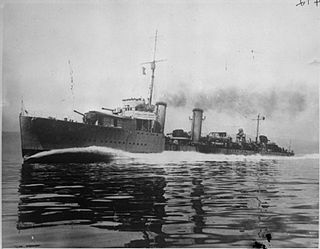Second World War
Following conversion to an anti-aircraft cruiser, Calcutta joined the Home Fleet in August 1939 and in September was allocated to the Humber Force, acting as an anti-aircraft escort for convoys in the North Sea. She returned to the Home Fleet in February but continued to escort convoys as well as the Fleet. [6] [7]
In April 1940, Germany invaded Norway and Calcutta was one of the units of the Home Fleet deployed in response. From 22–23 April, Calcutta, along with the cruiser Birmingham, the destroyer Maori, the sloop Auckland and the French destroyers Bison and Foudroyant, escorted the French troopship Ville d'Alger which was landing troops at Namsos but the operations were disrupted by poor weather. [6] [14] On 30 April, operations began to evacuate British and French troops from Åndalsnes, with Calcutta providing anti-aircraft cover for the evacuation operations. Calcutta and Auckland evacuated the rearguard from Åndalsnes on the night of 1/2 May, with Calcutta embarking 756 officers and men. [6] [14] [15]
At the end of May 1940, Calcutta took part in Operation Dynamo, the evacuation of the British Expeditionary Force from Dunkirk. [16] She evacuated 656 troops on the night of 27/28 May 1940, [17] when she operated off La Panne, [18] and a further 1,200 troops on the night of 28/29 May. [19] Calcutta again operated off Dunkirk on the night of 31 May/1 June, [20] [21] and was slightly damaged by near-misses by German bombs on 2 June. [21] [22]
Following the completion of the evacuation from Dunkirk, British Forces continued to operate in France, with Operation Aerial taking part in the second half of June 1940 to evacuate the remainder of British forces from ports in the west of France. Calcutta took part in Operation Aerial, providing anti-aircraft cover for evacuations from Saint-Jean-de-Luz in the far south-west of France, near the border with Spain from 23 to 25 June, when the Armistice between France and Germany ended the evacuations. On the return journey, Calcutta was in company with the Canadian destroyers HMCS Restigouche and Fraser, when on the evening of 25 June Calcutta collided with Fraser off the Gironde estuary, cutting the destroyer in two. The front of Fraser sank quickly, while the aft part was scuttled by Restigouche. [23] [24] Calcutta was undamaged. [25]
On 30 August Calcutta set off from Gibraltar as part of Operation Hats, which had the purpose of strengthening the British Mediterranean Fleet based in Egypt while simultaneously escorting a supply convoy to Malta. Calcutta formed part of Force F, the reinforcements for the Mediterranean Fleet, and together with sister ship Coventry and the battleship Valiant delivered personnel and stores to Malta on 2 September after Force F met up with the Mediterranean Fleet, reaching Alexandria on 6 September. [26] [27] On 8 October 1940, Calcutta, together with Coventry and four destroyers, formed the close escort of Convoy MF.3 to Malta, reaching Malta on 11 September, with Calcutta and Coventry forming part of the escort of the return convoy MF4. [6] [28] [29]
Calcutta provided anti-aircraft support for the battleships Warspite, Valiant and Barham when they bombarded Bardia on 3 January, then on 7 January set off from Alexandria as part of the escort of Malta Convoy MW5. This was part of a complex series of operations, with another Malta convoy, Operation Excess being simultaneously run from Gibraltar. Convoy MW5 arrived unharmed at Malta on 10 January, but the escort for the Operation Excess convoy was heavily hit by German dive bombers, sinking the cruiser Southampton and badly damaging the aircraft carrier Illustrious and the cruiser Gloucester. [30] [31] During March 1941, Calcutta escorted a series of troop convoys, known as Operation Lustre, carrying four British divisions from Egypt to Greece. [32] An Italian attempt to attack these convoys resulted in the Battle of Cape Matapan in which three Italian heavy cruisers were sunk. [33]
On 18 April 1941 Calcutta sailed with the Mediterranean Fleet when it escorted the fast transport Breconshire to Malta, continuing to escort the fleet as it bombarded the port of Tripoli on 20 April. [34] [35] On 24 April, the Mediterranean Fleet launched Operation Demon, the evacuation of British and Commonwealth forces from Greece, with Calcutta taking part in the evacuations. [36] [37] Between 6 and 12 May, Calcutta set out from Alexandria as part of the escort of Malta-bound convoy MW7, before joining the Operation Tiger convoy ferrying tanks from Gibraltar to Egypt. [38] [39]
On 20 May, Germany launched an invasion of Crete by airborne troops. The British Mediterranean Fleet deployed to counter any sea-borne reinforcement of the German forces, with three groups of cruisers and destroyers (Forces B, C and D) deployed to the north of Crete to intercept invasion convoys, while a force of battleships and destroyers (Force A1) provided cover in case the Italian Navy attempted to intervene. [40] Calcutta was sent from Alexandria to join Force C, meeting it on 21 May. Force C came under heavy attack by German and Italian aircraft during 21 May, with the destroyer HMS Juno (F46) being sunk. On 22 May Force C intercepted a convoy of Caïques carrying German troops to Heraklion, escorted by the Sagittario. While the convoy was forced to turn back, heavy German air attacks caused the commander of Force C, Rear-Admiral King, to break off the attack. The air attacks damaged the cruisers Naiad and Carlisle before Force C rejoined the covering Force A1. Further attacks on the combined force damaged the battleships Warspite and Valiant and sank the cruisers Gloucester and Fiji and the destroyer Greyhound. Force A1 was ordered back to Alexandria early on 23 May to restock anti-aircraft ammunition. [41] [42] [43]
On 27 May, the deteriorating situation on Crete resulted in the evacuation of Allied forces being ordered, with Calcutta along with the cruisers Coventry, Phoebe and Perth, the destroyers Jervis, Janus and Hasty and the transport Glengyle evacuating 6,000 troops from Sfakia on the night of 29/30 May 1941. [44] On the night of 31 May/1 June 1941, a final effort was made to evacuate the remaining troops from Sfakia, with the cruiser Phoebe, the minelayer Abdiel and the destroyers Kimberley, Hotspur and Jackal picked up a further 3,710 men. Calcutta and Coventry set out from Alexandria on 1 June to provide extra anti-aircraft protection for this force, but the two ships were attacked by two Junkers Ju 88 bombers of Lehrgeschwader 1, which dived out of the sun, giving little warning, about 100 nautical miles (190 km) north-west of Alexandria. Calcutta was hit by two bombs and sank, with 255 men being rescued by Coventry and 107 men killed or missing. [43] [45] [46]
